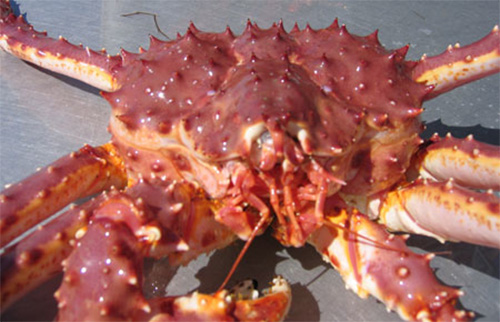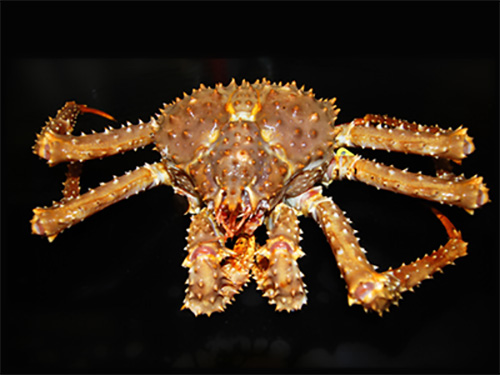|
Fish Factor Alaska red king crab, snow crab fetch record prices; Crab updates from Southeast AK to Bering SeaBy LAINE WELCH
March 03, 2017
The year’s first red king crab fishery at Norton Sound has yielded 17,000 pounds so far of its nearly 40,000 pound winter quota for more than 50 local fishermen. The crab, which are taken through the ice near Nome, are paying out at a record $7.75 a pound. A summer opener will produce a combined catch of nearly half a million pounds for the region. Red king crab from Bristol Bay also yielded the highest price ever for fishermen, averaging $10.89 per pound. That catch quota of eight million pounds was down 15 percent from the previous season.
Red King Crab; Paralithodes camtschaticus
Alaska produces only about 10 percent of the world’s snow crab, with most of the pack by far coming from Eastern Canada, followed by Russia. On the snow crab menu front - McDonald's has begun testing a new snow crab sandwich in several San Francisco Bay locations. If it’s a hit, the sandwich could advance to nearly 250 outlets this year. Since mid-February, about 100 small boat crabbers in Southeast Alaska have been hauling pots for 105,000 pounds of golden king crab, which can reach as high as $10 a pound at the docks. A local Tanner crab fishery just wrapped up, with a catch that will likely come in at around one million pounds.
Golden King Crab; Lithodes aequispinus
“It’s largely the opinion of the people around here that the fishery could support an expanded harvest,” said John Whissel, director of natural resources for the Native Village of Eyak. “The goal here is to get away from the boom and bust cycle, where the town doubles in size in May and then shrinks when the salmon fisheries wind down.” “There’s other opportunities around here and with oil prices being what they are and the tax rate being what it is,” he added. “Commercial fishing could play a larger role in the state budget if we gave them more chances to do that.” Along with supply and demand, the value of global currencies has a major influence on seafood sales in world markets. Exchange rates among competing currencies impact all Alaska seafoods because they alter the value of the products being exported to foreign markets along with competing products coming into our nation. The U.S. dollar (USD) value increased 27 percent between 2011 and 2015, tamping down the dockside value of Alaska seafood by 17 percent. Today, the dollar index remains roughly unchanged from last year and signals by our major purchasers are mixed. “The USD bull market has entered its sixth year and we are told to expect the USD to regain broad-based strength in 2017,” reported Poundsterlinglive.com, adding that the British Pound is valued at 1.22 against the dollar. “The Euro also is still weaker and who knows if that will continue, but it has been the trend for the last three years,” said Andy Wink, senior fisheries analyst with the McDowell Group. “One Euro was worth $1.10 in U.S. dollars last year and now it only buys about $1.05. So it takes more Euros to buy things denominated in dollars.” “That’s been under a lot of price pressure and the currency market is not doing us any favors,” Wink said. “A lot of cod also goes to Europe so it’s going to make things tougher for cod. All of those products are going to face a tougher marketing year than the previous year.” The currency outlook is more hopeful for one of Alaska’s biggest customers, Japan. “Right now the yen is getting stronger,” Wink explained. “It was around 120 Yen to the dollar and now it’s closer to 112. So the dollar isn’t worth as many Yen as it was just a few months ago.” Elsewhere, currencies in places like Brazil and Eastern Europe are in the tank. Exchange rates don’t come into play as much with China, Wink said, because the Yuan is pegged to the value of the US dollar. The Pacific halibut fishery will open as scheduled on March 11. Fears were running wild that a 60-day freeze on all new and pending regulations imposed by Donald Trump would delay the start of the eight-month season. On Friday U.S. Senator Dan Sullivan (R-AK) announced that the regulations necessary to open the fishery were posted in federal lawbooks and the halibut fishery will open on time. Sullivan, who chairs the Subcommittee on Oceans, Atmosphere, Fisheries, and Coast Guard, said it is an issue his office has been working on for weeks and credited new Secretary of Commerce Wilbur Ross for expediting the paper work. The new rules allowing pot gear to catch sablefish in the Gulf of Alaska were also approved. Fishermen have long pushed for the use of pots to prevent whales from robbing the sablefish from hook and line gear. “I will be speaking with Secretary Ross again to express my thanks on behalf of Alaskan fishermen,” Sullivan said.
Laine Welch ©2017 Laine can be reached
at msfish[AT]alaska.com
Representations of fact and opinions in comments posted below are solely those of the individual posters and do not represent the opinions of Sitnews.
SitNews ©2017 Stories In The News Ketchikan, Alaska
|
||


